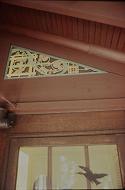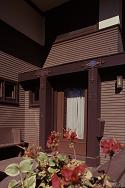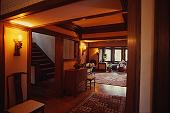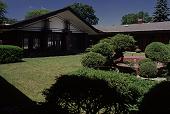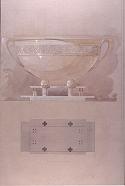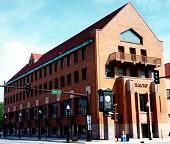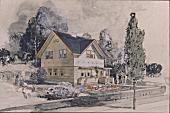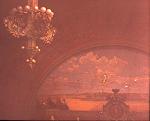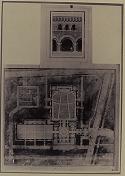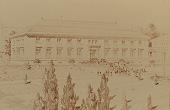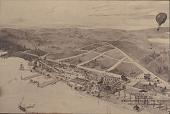|
|
|
Purcell and Elmslie, Architects Firm active :: 1907-1921
Minneapolis, Minnesota :: Chicago,
Illinois |
Ye Older Grindstones
8/22/2004
- 8/31/2004
8/31/2004
Charles I. Buxton residence
Owatonna, Minnesota 1912
John H. Adair residence Owatonna, Minnesota 1913
Edward L. Powers residence
Purcell, Feick, and Elmslie
Minneapolis, Minnesota 1910
Service Buildings for Henry B. Babson
Riverside, Illinois 1915
Dj-dipity II. More singles and a few doubles, continued. The sawed wood panel at the Buxton bungalow is very interesting, and is the only instance I have seen where a large P&E sawed wood retains the (it appeared to me at the time) original polychrome treatment. There are small decorative sawed wood enrichments on the Adair house that have some color, but I don't know if it is original. Purcell commented that the panel installed over his father's front porch in 1915 was brightly painted in the same way; given the size of the now mute brown curves, what a sight that must have been. A sort of eternal spring. At least we have the surviving terra-cotta in the canon, which tends to be more enduring (although not always, as you can read in Purcell's comments concerning the Electric Carriage and Battery Company facade that was demolished to widen a street in Minneapolis). There's great irony in that, since Purcell had prepared a master plan for the development of one of the streets near where the electric car garage was built. Some years ago, while I was still working with the Purcell Papers, a woman came into the Northwest Architectural Archives to check if the building that housed an engineering firm where she worked was the remains of the P&E garage. Lo, so it was. [Again, these links go directly to the enlarged view.]
- Front view, Buxton bunaglow
- Sawed wood panel, Buxton bungalow
- Perspective view, John H. Adair residence
- Front entrance, John H. Adair residence
- Vestibule/hallway, E. L. Powers residence
- Courtyard and main building, Babson service buildings
8/23/2004
Aviation Cup for Robert Jarvie
Purcell, Feick and Elmslie
Chicago, Illinois 1911
"Chicago River"
Albert Fleury, artist
ca. 1900s
Fritz Carlson residence
Purcell and Elmslie
Minneapolis, Minnesota 1917/1923
National Farmers Bank
Louis H. Sullivan and George Grant Elmslie, architects
Owatonna, Minnesota 1905Dj-dipity. Clearing a way through the forest to the various thematic presentations I want to devise for Island Lake, Portland, and Westwinds means first adding a number of one-sies that will pepper the site. It's easier just to list these without comment (don't worry, I put notes into the new pages), but at least this way those who use the Grindstone to keep in touch with developments can add to their vista without missing some of these cool images. The 1,667 IMAGES links on this web site go directly to the enlarged version, as these are mostly new photograph among many that were already present.
- Presentation rendering, Aviation Cups for Robert Jarvie
- "Chicago River" by Albert Fleury, purchased by Purcell for Lake Place
- Presentation rendering for the Fritz Carlson house, close to the true colors of the drawing
- Lumiere autochrome showing the National Farmers Bank banking room in 1914 (very mystical)
- Perspective view, 1992
Credit: Photograph by Scot Zimmerman
, of the Thomas W. Snelling residence- Two views of the Charles A. Purcell residence #2, including another "airplane window"
8/22/2004
Farm Village for William E. Benson, project
Kowaliga, Alabama 1901
Design for Andrew D. White Competition 1902
California Hall
University of California
Berkeley, California 1905
John Galen Howard, architect
William Gray Purcell, Clerk of the Works
Amusement Park
A. Warren Gould, architect
William Gray Purcell, delineator 1906
After the Beginning, Before the Start. I've added a list of early works by Purcell, pre-P&E Designs and Projects, 1899-1906, which includes a scope and content note about this group of records as they survive in the Purcell Papers. Purcell started his war against revivalism early on. Beginning with his matriculation at the newly founded College of Architecture at Cornell University--which had a reputation as a progressive school, by the way--Purcell constantly spoke up for the "New Architecture" that was familiar to him in Chicago but largely alien to those around him. He had one or two professors who knew at least something about Sullivan and Wright, but mostly both the faculty and his classmates were to be little persuaded toward these new forms of building design. All that came to a satisfying denouement in 1902, when Purcell won the prestigious Andrew D. White Competition. His straightforward, non-Classical design was highly praised by Andrew White, to the chagrin of both teachers and competitors. Upon receipt of his First Prize money award, Purcell characteristically donated the cash to the College of Architecture to buy and frame some fine architectural prints. Pure noblesse oblige.

